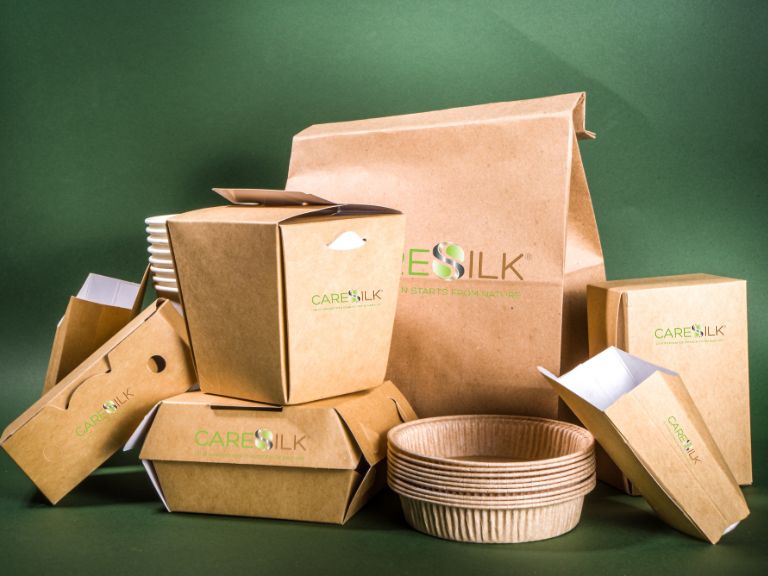The global intelligent packaging market will grow from $24.66 billion in 2025 to $40.02 billion by 2032, with an annual growth rate of 6.24%, signaling an increasingly pressing demand for innovative solutions that go beyond simple product protection.
In this scenario, silk proteins are increasingly rapidly providing indications for a real and profound line of innovation in the food packaging sector. As we know, over 40% of packaged fresh food and agricultural products end up in the trash while more than 800 million people worldwide suffer from malnutrition, making the development of technologies capable of significantly extending food shelf-life urgent.
An invisible coating that changes everything
Protein coating technology now represents in a more than visible way that long-sought approach for a new type of food preservation. The coating developed by some companies has the thickness of just two red blood cells, and can be tasteless and invisible, thus giving food a drastically longer shelf life without altering it in any way. This innovation is based on a fundamental biological principle, namely using the same proteins that in nature protect living organisms to create a protective barrier around food.
The application process is surprisingly simple but scientifically sophisticated. With just water, salt and heat, companies extract silk proteins creating an aqueous solution that self-assembles on the surface of food through an immersion process. Post-processing control of protein polymorphism allows modulation of gas diffusion through the coating, enabling precise regulation of cellular respiration in foods.
The science behind shelf-life extension
The preservation capacity of these protein coatings manages to operate on multiple simultaneous levels. Silk proteins applied as an edible coating extend shelf life by slowing dehydration and reducing oxidative stress. This dual mechanism of action addresses two of the main causes of food deterioration: moisture loss and oxidation.
Experimental results demonstrate the practical effectiveness of this technology. Strawberries and bananas dipped in the coating and stored at 22°C for seven days remain firm and fresh, while uncoated fruit discolors and loses consistency. This data highlights how the technology can work effectively even at room temperature, drastically reducing the need for refrigeration during transport and storage.
Towards packaging that senses and reacts
The most promising evolution of this technology lies in the integration of advanced sensory functionalities. Bio-based sensors for intelligent packaging make use of indicators applied in packaging that detect changes in physiological variations of foods due to microbial and chemical degradation. These systems provide real-time information on the degree of freshness through color changes easily identifiable by distributors and consumers.
Intelligent and antimicrobial packaging technologies are transforming meat preservation by improving food safety, enabling real-time quality monitoring and extending shelf life. The integration of silk proteins with these sensory systems is creating a new generation of "living" packaging capable of dynamically adapting to the conditions of the food they contain.
Environmental impact and supply chain sustainability
The environmental dimension then marries perfectly with the dictates of this technology. Silk proteins represent a safe and effective source for extending the shelf life of fruits and vegetables while reducing the use of plastics and associated environmental pollution. This aspect takes on particular relevance in a context where the search for sustainable alternatives to traditional plastics has become a priority for the food industry.
The complete biodegradability of these protein materials eliminates the problem of packaging disposal, creating a circular system where packaging becomes an integral part of the food ecosystem. The extraction of proteins from abandoned cocoons remains relatively economical, ensuring not only environmental but also economic sustainability of the production process.
The implementation on an industrial scale of this technology is redefining it is clear that it has already been having a "healthy" impact on global food logistics for some time. Extending the shelf life of the world's food supply at room temperature even for just one week would represent an enormous advantage for agriculture and the food industry. This room temperature preservation capacity drastically reduces the energy costs of the cold chain and expands the possibilities for geographical distribution of fresh food.
The reduction of dependence on continuous refrigeration means new possibilities for emerging markets and geographically isolated areas, democratizing access to fresh and quality food. Simultaneously, the reduction of food waste at the retail and final consumption level contributes significantly to the overall sustainability of the global food system.
Future innovations and technological developments
Genetic engineering techniques could contribute to obtaining higher protein yields, leading in the future to silk proteins with new capabilities and more economically competitive products. We could then already speak of a second generation of protein materials with even more advanced functionalities, potentially capable of releasing active preservative ingredients or modifying their properties in response to specific environmental triggers.
Integration with digital technologies promises to create intelligent traceability systems where each individual food product can communicate its preservation status through the network, optimizing stock management and further reducing waste. This convergence between biotechnologies and digitalization represents the next horizon of innovation in the food packaging sector.
The transition towards intelligent protein packaging does not represent only a technological evolution, but a true conceptual revolution that redefines the relationship between food, packaging and environment. In a world where sustainability and efficiency have become categorical imperatives, these bio-based solutions offer a concrete path towards a more resilient and responsible food system.


